Characteristics of Rain-Induced Attenuation over Signal Links at Frequency Ranges of 25 and 38 GHz Observed in Beijing
Abstract
1. Introduction
2. Materials and Methods
2.1. Rainfall Measurement Equipment
2.2. Particle Size Distribution and Rainfall Rate
2.3. Outdoor Field Millimeter-Wave Measurement
2.4. Estimation of Rain-Induced Attenuation Over Millimeter-Wave Links
2.5. Estimation of Rainfall Rate Using Millimeter-Wave Link
3. Results and Discussion
3.1. Rainfall Statistics
3.2. Rain-Induced Attenuation Over Millimeter-Wave Links and Power Law Coefficients Based on Local DSD Measurement
3.3. Estimated Rainfall Rate Using Millimeter-Wave Link
4. Discussion
5. Conclusions
Author Contributions
Funding
Institutional Review Board Statement
Informed Consent Statement
Data Availability Statement
Conflicts of Interest
References
- Daniels, R.C.; Heath, R.W.; Murdock, J.N.; Rappaport, T.S. Millimeter Wave Wireless Communications; Pearson: Upper Saddle River, NJ, USA, 2014; ISBN 978-0-13-217228-8. [Google Scholar]
- Han, C.; Huo, J.; Gao, Q.; Su, G.; Wang, H. Rainfall monitoring based on next-generation millimeter-wave backhaul technologies in a dense urban environment. Remote Sens. 2020, 12, 1045. [Google Scholar] [CrossRef]
- Zhang, G.; Han, C.; Ji, B.; Shi, C.; Xie, P.; Yang, L. A new multiple-symbol differential detection strategy for error-floor elimination of IEEE 802.15.4 BPSK receivers impaired by carrier frequency offset. Wirel. Commun. Mob. Comput. 2019, 2019, 1–26. [Google Scholar] [CrossRef]
- Lin, T.; John, G. WRC-19 Revamps ITU Radio Regulations to Accommodate Emerging Communications Technologies. Available online: https://www.hlregulation.com/2019/12/20/wrc-19-revamps-itu-radio-regulations-to-accommodate-emerging-communications-technologies/ (accessed on 20 December 2019).
- Liebe, H.J.; Hufford, G.A.; Cotton, M.G. Propagation modeling of moist air and suspended water/ice particles at frequencies below 1000GHz, Electromagnetic Wave Propagation Panel Symposium. In Proceedings of the AGARD Conference Proceedings, Palma De Mallorca, Spain, 17–20 May 1993. [Google Scholar]
- Atlas, D.; Ulbrich, C.W. Path- and area-integrated rainfall measurement by microwave attenuation in the 1–3 cm band. J. Appl. Meteorol. 1977, 16, 1322–1331. [Google Scholar] [CrossRef]
- Medhurst, R.G. Rainfall attenuation of centimeter waves: Comparison of theory and measurement. IEEE Trans. Antennas Propag. 1965, 13, 550–564. [Google Scholar] [CrossRef]
- Olsen, R.L.; Rogers, D.V.; Hodge, D.B. The aRb relation in calculation of rain attenuation. IEEE Trans. Antennas Propag. 1978, 26, 319–329. [Google Scholar] [CrossRef]
- ITU-R P. 838-3 (International Telecommunication Union Radiocommunication Bureau Propagation Recommendation), Specific Attenuation Model for Rain for Use in Prediction Methods, 03/2005. Available online: https://www.itu.int/rec/R-REC-P.838-3-200503-I/en (accessed on 30 January 2021).
- Wang, W.-C. Rainy Season at Beijing and Shanghai Since 1736. J. Meteorol. Soc. Jpn. 2008, 86, 827–834. [Google Scholar] [CrossRef][Green Version]
- Messer, H.; Zinevich, A.; Alpert, P. Environmental monitoring by wireless communication networks. Science 2006, 312, 713. [Google Scholar] [CrossRef]
- Messer, H. Capitalizing on Cellular Technology—Opportunities and Challenges for Near Ground Weather Monitoring. Environ. Sci. Technol. 2018, 5, 73. [Google Scholar] [CrossRef]
- Chwala, C.; Kunstmann, H. Commercial Microwave Link Networks for Rainfall Observation: Assessment of the Current Status and Future Challenges. Wiley Interdiscip. Rev. Water 2018, 6, 2018. [Google Scholar] [CrossRef]
- Uijlenhoet, R.; Overeem, A.; Leijnse, H. Opportunistic remote sensing of rainfall using microwave links from cellular communication networks. Wiley Interdiscip. Rev. Water 2018, 5, e1289. [Google Scholar] [CrossRef]
- Tokay, A.; Short, D.A. Evidence from tropical raindrop spectra of the origin of rain from stratiform versus convective clouds. J. Appl. Meteorol. 1996, 35, 355–371. [Google Scholar] [CrossRef]
- Available online: https://www.ott.com/products/meteorological-sensors-26/ott-parsivel2-laser-weather-sensor-2392/ (accessed on 30 January 2021).
- Park, S.G.; Kim, H.L.; Ham, Y.W.; Jung, S.H. Comparative Evaluation of the OTT PARSIVEL2 Using a Collocated Two-Dimensional Video Disdrometer. J. Atmos. Ocean. Technol. 2017, 34, 2059–2082. [Google Scholar] [CrossRef]
- Atlas, D.; Ulbrich, C.W.; Marks, F.D., Jr.; Black, R.A.; Amitai, E.; Willis, P.T.; Samsury, C.E. Partitioning tropical oceanic and stratiform rains by draft strength. J. Geophys. Res. 2020, 105, 2259–2267. [Google Scholar] [CrossRef]
- Atlas, D.; Ulbrich, C.W. Drop size spectra and integral remote sensing parameters in the transition from convective to stratiform rain. Geophys. Res. Lett. 2006, 33, L16803. [Google Scholar] [CrossRef]
- Tokay, A. Comparison of drop size distribution measurements by impact and optical disdrometers. J. Appl. Meteorol. 2001, 40, 2083–2097. [Google Scholar] [CrossRef]
- Wu, Z.; Zhang, Y.; Zhang, L.; Lei, H.; Xie, Y.; Wen, L.; Yang, J. Characteristics of summer season raindrop size distribution in three typical regions of western pacific. Geophys. Res. Atmos. 2019, 124, 4054–4073. [Google Scholar] [CrossRef]
- Wen, G.; Xiao, H.; Yang, H.; Bi, Y.; Xu, W. Characteristics of summer and winter precipitation over northern China. Atmos. Res. 2017, 197, 390–406. [Google Scholar] [CrossRef]
- Tang, Q.; Xiao, H.; Guo, C.; Feng, L. Characteristics of raindrop size distributions and their retrieved polarimetric radar parameters in northern and southern China. Atmos. Res. 2014, 135–136, 59–75. [Google Scholar] [CrossRef]
- Chen, B.; Hu, W.; Pu, J. Characteristics of the raindrop size distribution for freezing precipitation observed in southern China. J. Geophys. Res. Space Phys. 2011, 116, D06201. [Google Scholar] [CrossRef]
- Raupach, T.H.; Berne, A. Correction of raindrop size distributions measured by Parsivel disdrometers, using a two-dimensional video disdrometer as a reference. Atmos. Meas. Tech. 2014, 7, 8521–8579. [Google Scholar] [CrossRef]
- Fielding, M.D.; Chiu, J.C.; Hogan, R.J.; Feingold, G.; Eloranta, E.; O’Connor, E.J.; Cadeddu, M.P. Joint retrievals of cloud and drizzle in marine boundary layer clouds using ground-based radar, lidar and zenith radiances. Meas. Tech. Discuss. 2015, 8, 1833–1889. [Google Scholar]
- Hugh, M.; Wojciech, G. Comparison of bulk and bin warm-rain microphysics models using a kinematic framework. AMS J. Atmos. Sci. 2007, 64, 2839–2861. [Google Scholar]
- Miles, N.L.; Verlinde, J.; Clothiaux, E. Cloud droplet size distributions in low-level stratiform clouds. J. Atmos. Sci. AMS 2000, 57, 295–311. [Google Scholar] [CrossRef]
- Marshall, J.S.; Palmer, W.M.K. The distribution of rain drops with size. J. Meterol. 1945, 5, 165–166. [Google Scholar] [CrossRef]
- Levin, L.M. The coagulation of charged cloud-droplets size distribution function for cloud droplets and rain drops. Dokl. Akad. Nauk SSSR 1954, 94, 1045–1053. [Google Scholar]
- Ulbrich, C.W. Natural variations in the analytical form of the raindrop size distribution. J. Appl. Meteorol. 1983, 22, 1764–1775. [Google Scholar] [CrossRef]
- Cao, Q.; Zhang, G.; Brandes, E.A.; Schuur, T.J. Polarimetric radar rain estimation through retrieval of drop size distribution using a bayesian approach. J. Appl. Meteorol. Clim. 2010, 49, 973–990. [Google Scholar] [CrossRef]
- Huo, J.; Tian, Y.; Wu, X.; Han, C.; Liu, B.; Bi, Y.; Duan, S.; Lyu, D. Properties of ice cloud over Beijing from surface Ka-band radar observations during 2014–2017. Atmos. Phys. Chem. 2020, 20, 14377–14392. [Google Scholar] [CrossRef]
- Huo, J.; Li, J.; Duan, M.; Lv, D.; Han, C.; Bi, Y. Measurement of cloud top height: Comparison of MODIS and ground-based millimeter radar. Remote Sens. 2020, 12, 1616. [Google Scholar] [CrossRef]
- Matrosov, S.Y. Synergetic use of millimeter- and centimeter-wavelength radars for retrievals of cloud and rainfall parameters. Atmos. Chem. Phys. 2010, 10, 3321–3331. [Google Scholar]
- Protat, A.; Klepp, C.; Louf, V.; Petersen, W.A.; Alexander, S.P.; Barros, A.; Leinonen, J.; Mace, G.G. The Latitudinal variability of oceanic rainfall properties and its implication for satellite retrievals: 2. The relationships between radar observables and drop size distribution parameters. J. Geophys. Res. Atmos. 2019, 124, 13312–13324. [Google Scholar] [CrossRef]
- Zhou, L.; Dong, X.; Fu, Z.; Wang, B.; Leng, L.; Xi, B.; Cui, C. Vertical distribution of raindrops and Z-R relationships using microrain radar and 2-D video disdrometer measurements during the integrative monsoon frontal rainfall experiment (IMFRE). J. Geophys. Res. Atmos. 2020, 125, e2019JD031108. [Google Scholar] [CrossRef]
- Lam, H.Y.; Luini, L.; Din, J.; Capsoni, C.; Panagopoulos, A.D. Investigation of rain attenuation in equatorial Kuala Lumpur. IEEE Antennas Wirel. Propag. Lett. 2012, 11, 1002–1005. [Google Scholar] [CrossRef]
- Van Leth, T.C.; Overeem, A.; Leijnse, H.; Uijlenhoet, R. A measurement campaign to assess sources of error in microwave link rainfall estimation. Atmos. Meas. Tech. 2018, 11, 4645–4669. [Google Scholar] [CrossRef]
- Leijnse, H.; Uijlenhoet, R. The effect of reported high-velocity small raindrops on inferred drop size distributions and derived power laws. Atmos. Chem. Phys. 2010, 10, 6807–6818. [Google Scholar] [CrossRef]
- Murata, F.; Terao, T.; Chakravarty, K.; Syiemlieh, H.; Cajee, L. Characteristics of orographic rain drop-size distribution at Cherrapunji, Northeast India. Atmosphere 2020, 11, 777. [Google Scholar] [CrossRef]
- Guyot, A.; Pudashine, J.; Protat, A.; Uijlenhoet, R.; Pauwels, V.R.N.; Seed, A.; Walker, J.P. Effect of disdrometer type on rain drop size distribution characterisation: A new dataset for south-eastern Australia. Hydrol. Earth Syst. Sci. 2019, 23, 4737–4761. [Google Scholar] [CrossRef]
- Atlas, D.; Srivastava, R.C.; Sekhon, R.S. Doppler radar characteristics of precipitation at vertical incidence. Rev. Geophys. 1973, 11, 1–35. [Google Scholar] [CrossRef]
- Chen, B.; Yang, J.; Pu, J. Statistical characteristics of raindrop size distribution in Meiyu season observed in Eastern China. J. Meteorol. Soc. Jpn. 2013, 91, 215–227. [Google Scholar] [CrossRef]
- Bringi, V.N.; Chandrasekar, V.; Hubbert, J.; Gorgucci, E.; Randeu, W.L.; Schoenhuber, M. Raindrop size distribution in different climatic regimes from disdrometer and dual-polarized radar analysis. J. Atmos. Sci. 2003, 60, 354–365. [Google Scholar] [CrossRef]
- Fu, Z.; Dong, X.; Zhou, L.; Cui, W.; Wang, J.; Wan, R. Statistical characteristics of raindrop size distributions and parameters in Central China during the Meiyu seasons. J. Geophys. Res. Atmos. 2020, 125, 1–15. [Google Scholar] [CrossRef]
- Luini, L.; Roveda, G.; Zaffaroni, M.; Costa, M.; Riva, C.G. The impact of rain on short E-band radio links for 5G mobile systems: Experimental results and prediction models. IEEE Trans. Antennas Propag. 2020, 68, 3124–3134. [Google Scholar] [CrossRef]
- Han, C.; Bi, Y.; Duan, S.; Lu, G. Rain rate retrieval test from 25 GHz, 28 GHz, and 38 GHz millimeter-wave link measurement in Beijing. IEEE J. Sel. Top. Appl. Earth Obs. Remote Sens. 2019, 12, 2835–2847. [Google Scholar] [CrossRef]
- de Vos, L.W.; Raupach, T.H.; Leijnse, H.; Overeem, A.; Berne, A.; Uijlenhoet, R. High-resolution simulation study exploring the potential of radars, crowdsourced personal weather stations, and commercial microwave links to monitori small-scale urban rainfall. Water Resour. Res. 2018, 54, 10293–10312. [Google Scholar]
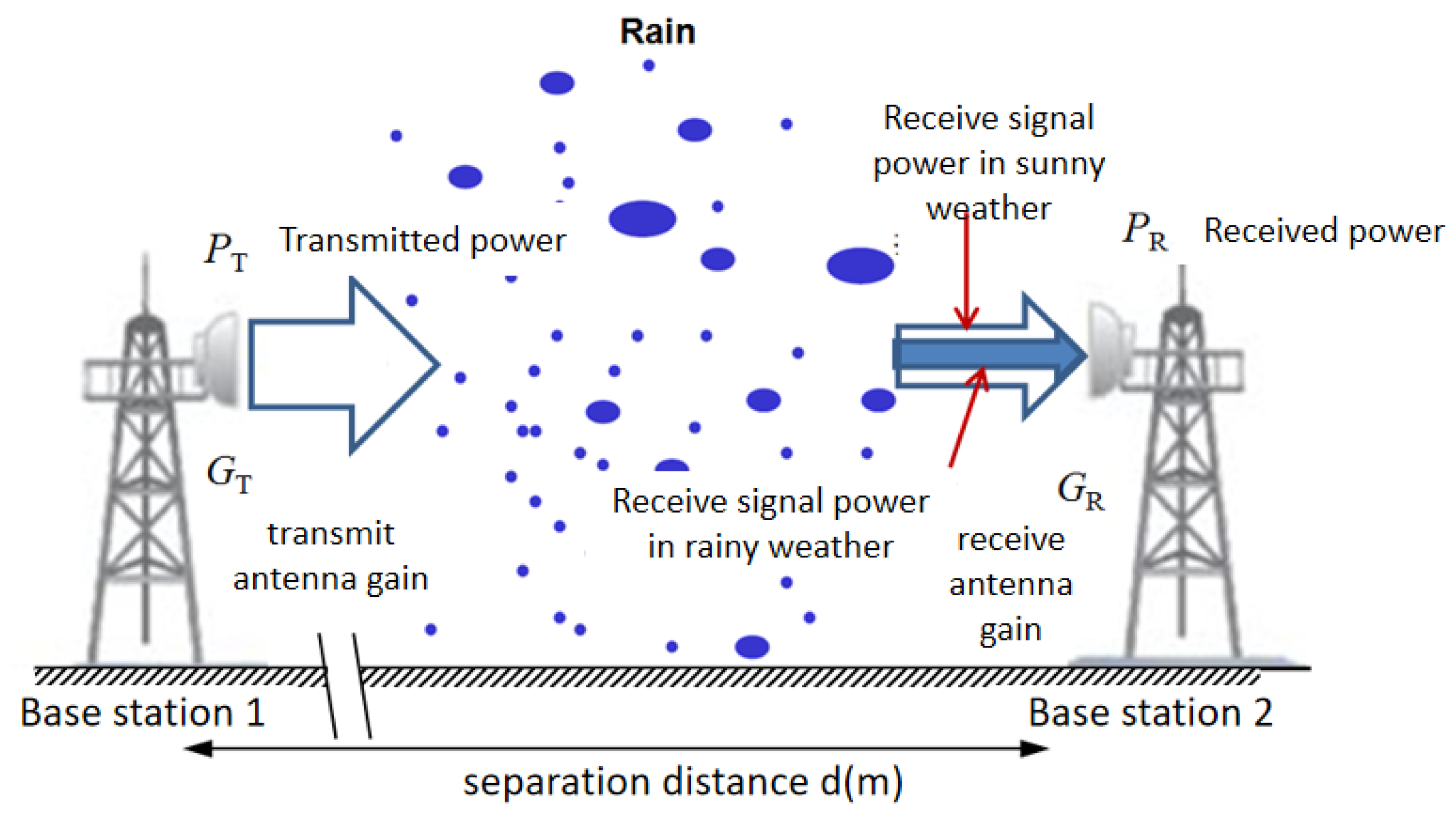
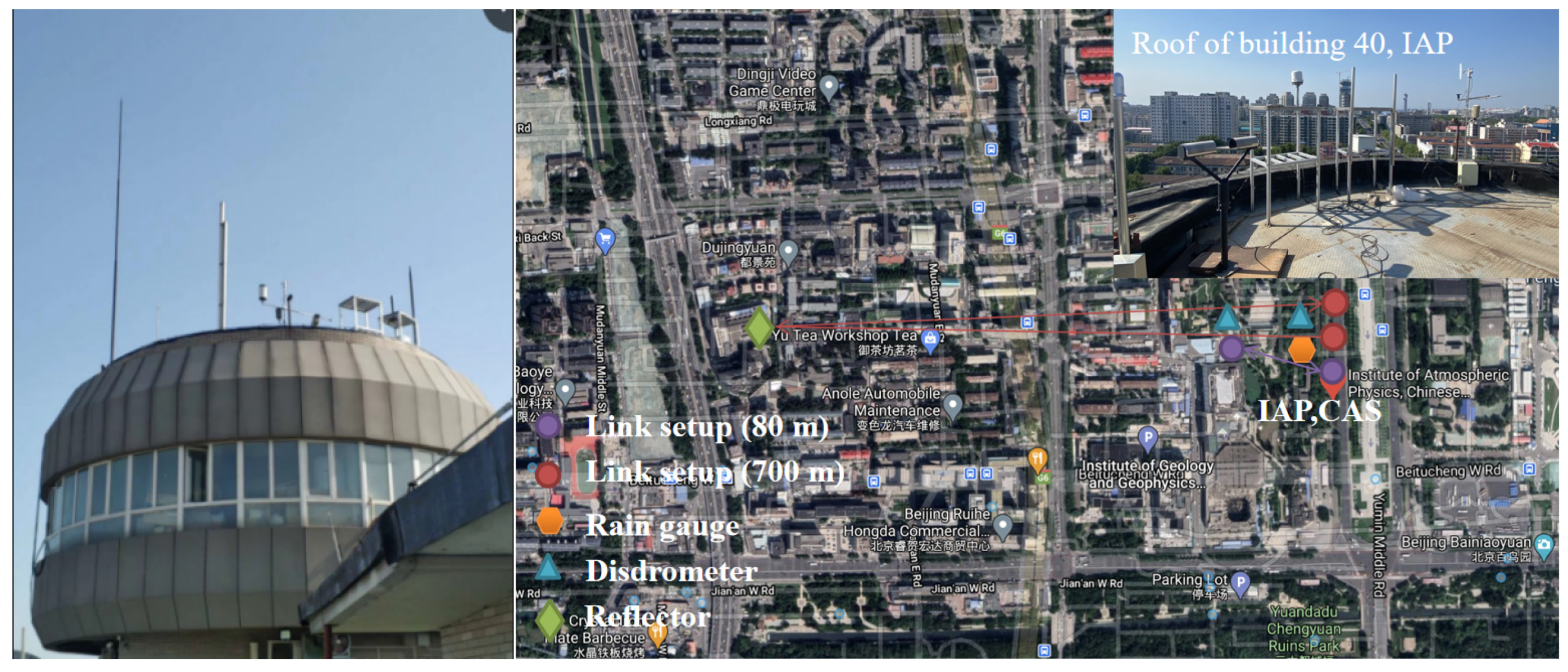
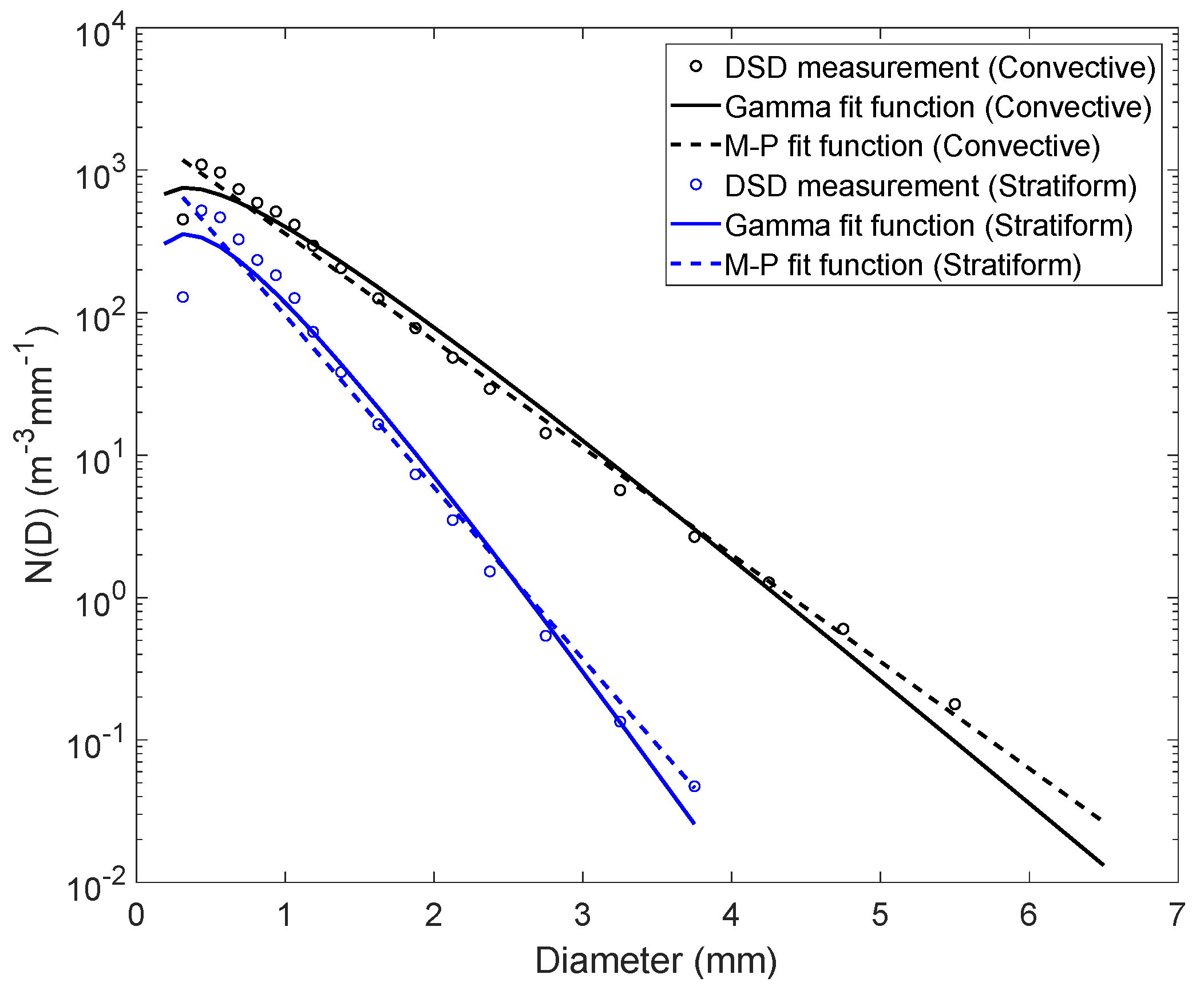
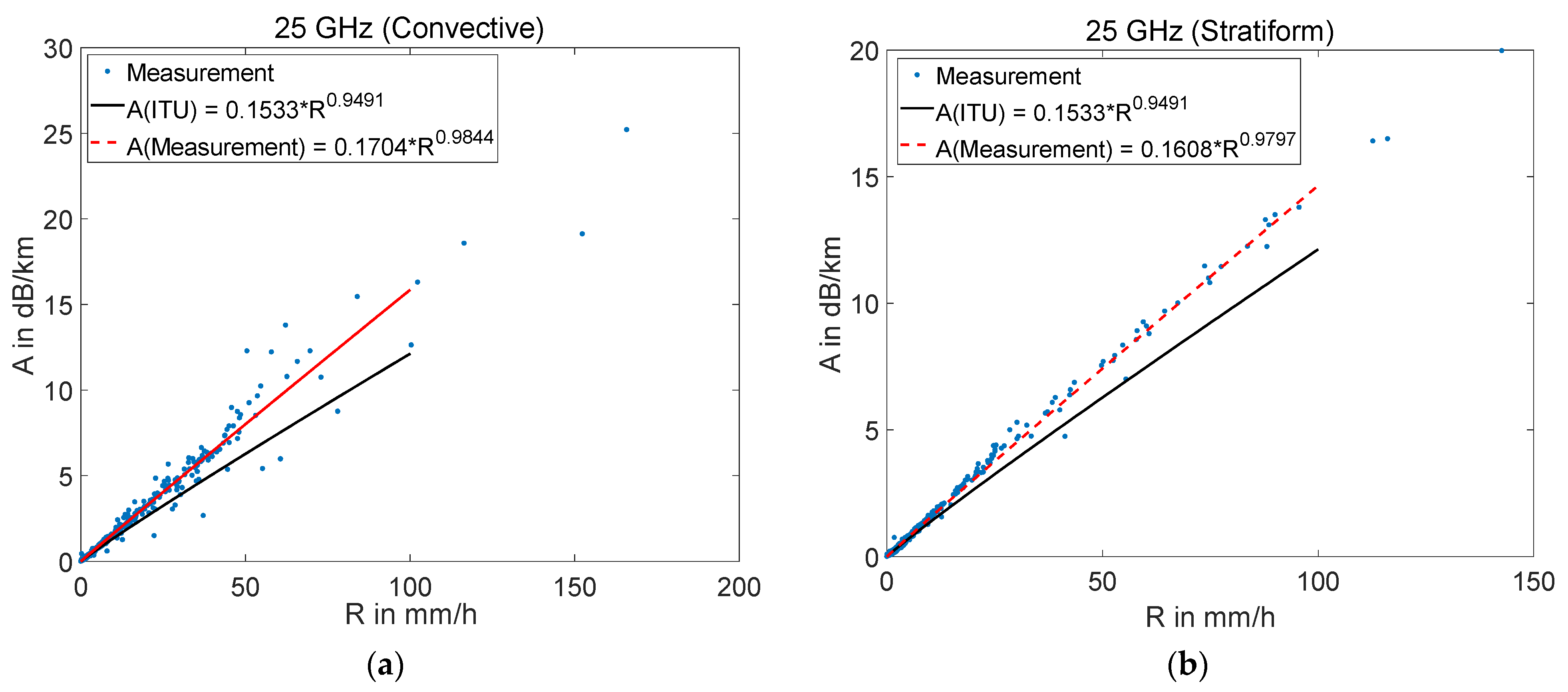
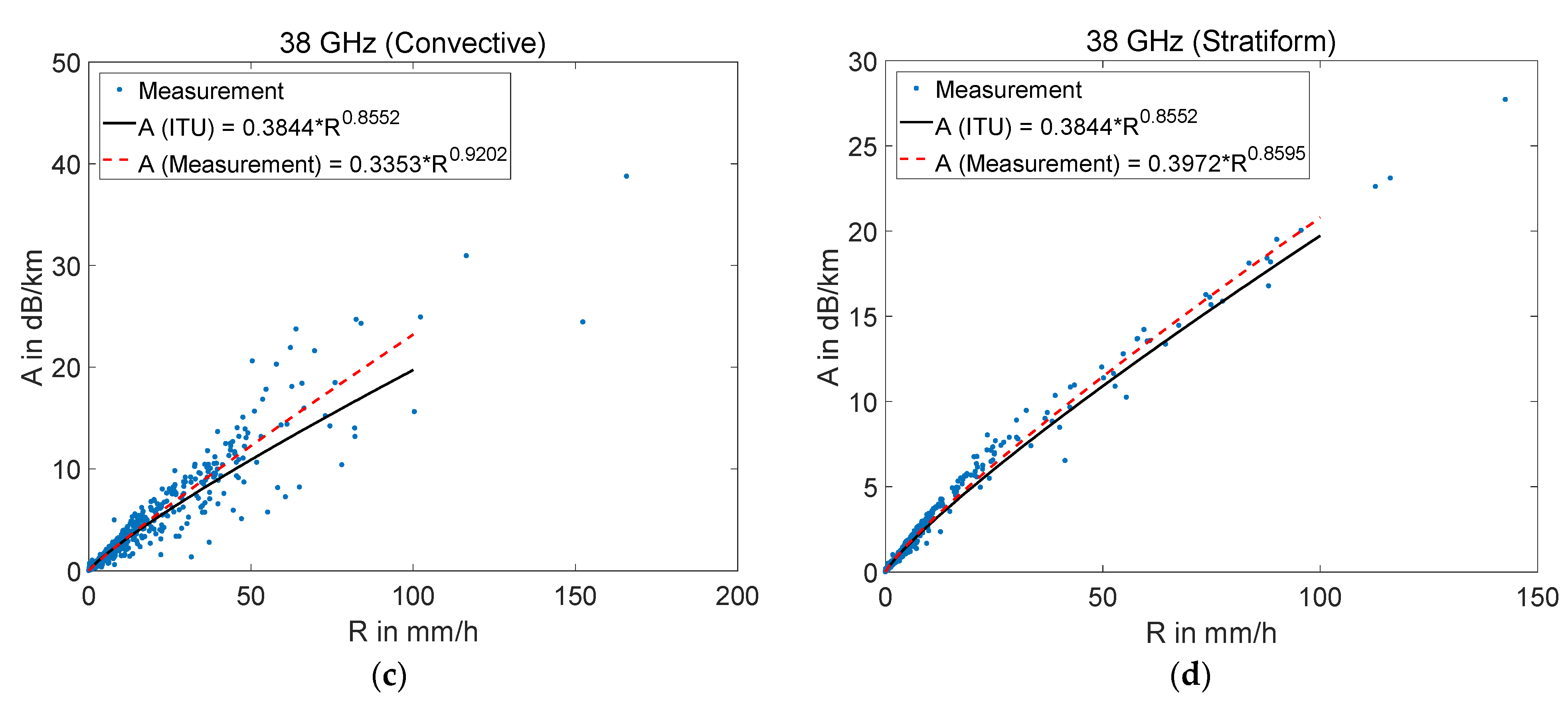
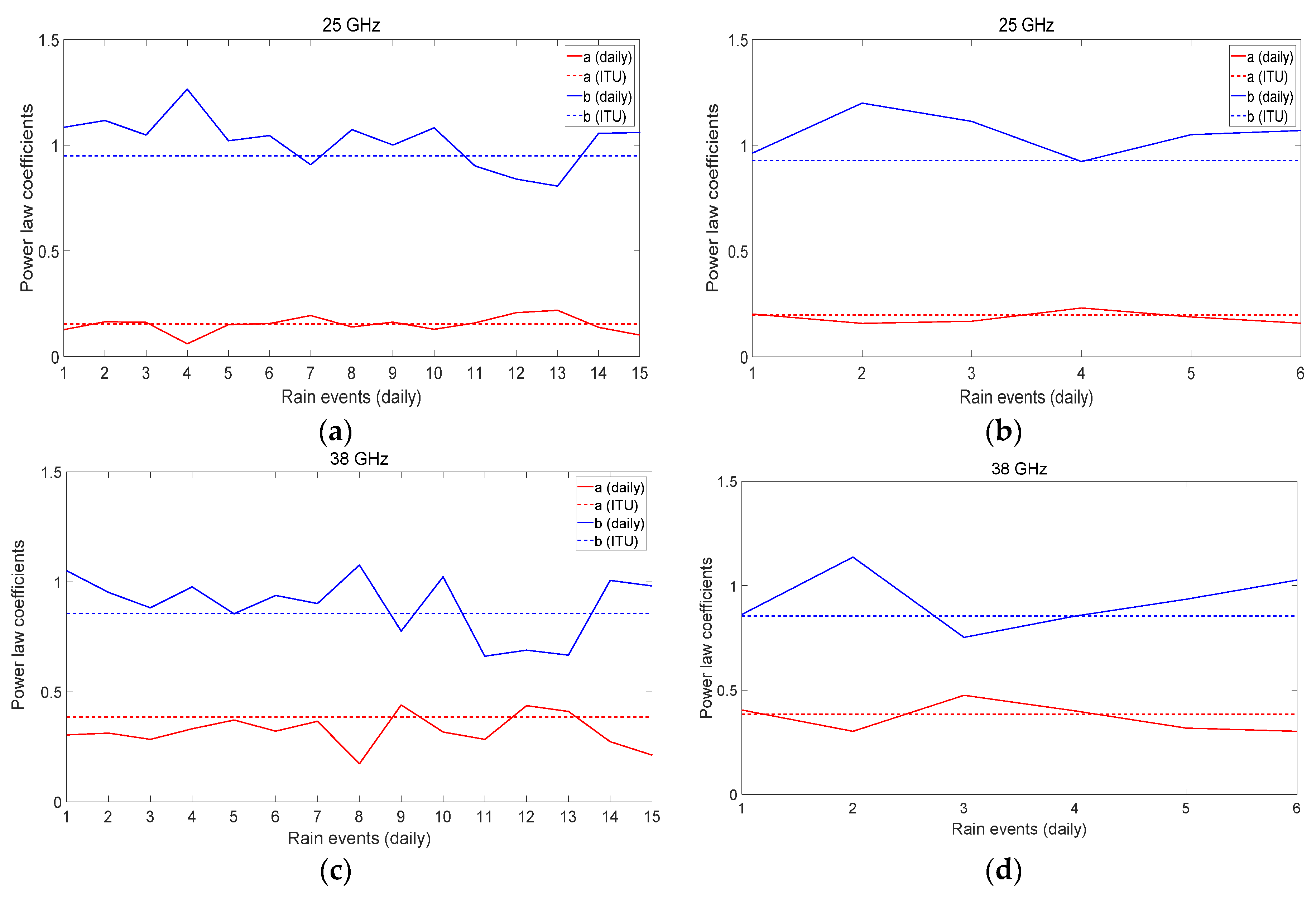

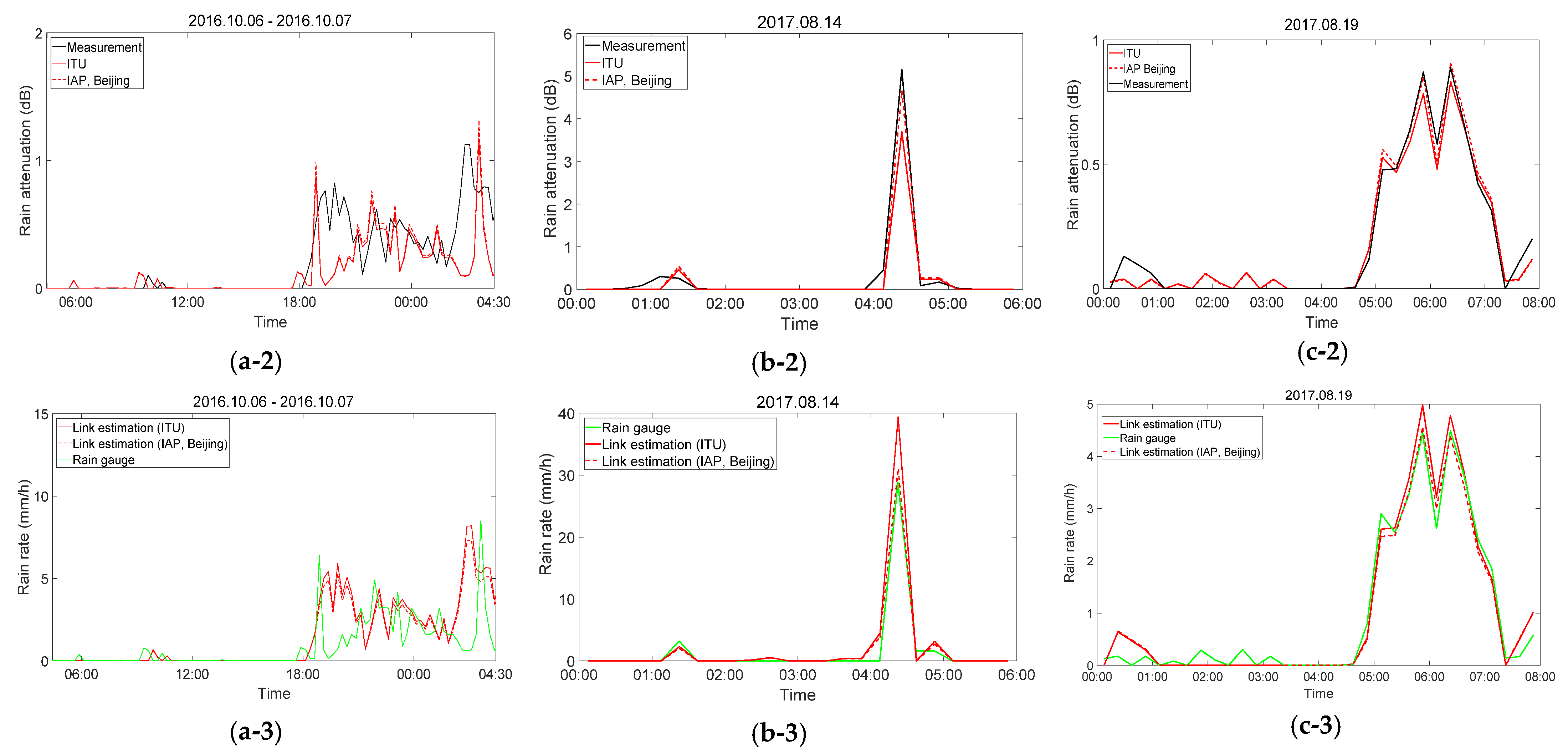
| Parameter | Value |
|---|---|
| Centre frequency | 25 GHz/38 GHz |
| Transmit power | 7 dBm |
| Transmitter instrument | Anritsu MG369XB signal generator |
| Receiver instrument | Agilent N9030A PXA signal analyzer |
| Antenna type | Horn antenna |
| Transmitter-Receiver (Tx-Rx) distance | 80 m/700 m |
| Sampling interval | 15 s |
| Tx antenna gain | 23.8 dBi (25 GHz)/25.6 dBi (38 GHz) |
| Rx antenna gain | 23.8 dBi (25 GHz)/25.6 dBi (38 GHz) |
| Polarization | Vertically polarized |
| Cable loss | 2 m (−2.2 dB), 3 m (−5.0 dB) |
| Tx and Rx azimuth half-power beamwidth | 11° (25 GHz)/8.4° (38 GHz) |
| Tx and Rx elevation half-power beamwidth | 10° (25 GHz)/7.4° (38 GHz) |
| Date (yyyy.mm.dd) | Rain Time (minutes) | Peak Rain Rate (mm/h) | Date (yyyy.mm.dd) | Rain Time (minutes) | Peak Rain Rate (mm/h) |
|---|---|---|---|---|---|
| 2017.06.22 | 1111 | 17.9 | 2018.06.09 | 99 | 17.1 |
| 2017.06.23 | 522 | 129 | 2018.06.12 | 58 | 32.6 |
| 2017.08.02 | 260 | 27.3 | 2018.06.13 | 42 | 14.3 |
| 2017.08.03 | 65 | 20.8 | 2018.06.17 | 275 | 150.9 |
| 2017.08.09 | 31 | 1.0 | 2018.06.25 | 47 | 2.5 |
| 2017.08.11 | 77 | 53.3 | 2018.07.11 | 770 | 21.8 |
| 2017.08.12 | 234 | 123.5 | 2018.07.12 | 179 | 4.1 |
| 2017.08.13 | 112 | 20.1 | 2018.07.16 | 230 | 121.4 |
| 2017.08.18 | 153 | 87.4 | 2018.07.17 | 535 | 168.2 |
| 2017.08.19 | 132 | 7.1 | 2018.07.24 | 292 | 22.4 |
| 2017.08.22 | 577 | 40.5 | 2018.08.11 | 68 | 113.5 |
| 2017.08.23 | 413 | 153.4 | 2018.08.13 | 62 | 37.5 |
| 2017.10.09 | 861 | 11.0 | 2018.08.18 | 284 | 56.4 |
| 2018.06.07 | 62 | 2.1 | 2018.08.19 | 33 | 1.5 |
| Date (yyyy.mm.dd) | Frequency | RITU | RIAP | ||
|---|---|---|---|---|---|
| 2016.10.06–07 | 25 GHz | 0.63 | 6.48 | 0.64 | 6.21 |
| 2017.08.14 | 25 GHz | 0.98 | 0.54 | 0.98 | 0.38 |
| 2017.08.19 | 38 GHz | 0.98 | 0.50 | 0.98 | 0.49 |
Publisher’s Note: MDPI stays neutral with regard to jurisdictional claims in published maps and institutional affiliations. |
© 2021 by the authors. Licensee MDPI, Basel, Switzerland. This article is an open access article distributed under the terms and conditions of the Creative Commons Attribution (CC BY) license (https://creativecommons.org/licenses/by/4.0/).
Share and Cite
Han, C.; Feng, L.; Huo, J.; Deng, Z.; Zhang, G.; Ji, B.; Zhou, Y.; Bi, Y.; Duan, S.; Yuan, R. Characteristics of Rain-Induced Attenuation over Signal Links at Frequency Ranges of 25 and 38 GHz Observed in Beijing. Remote Sens. 2021, 13, 2156. https://doi.org/10.3390/rs13112156
Han C, Feng L, Huo J, Deng Z, Zhang G, Ji B, Zhou Y, Bi Y, Duan S, Yuan R. Characteristics of Rain-Induced Attenuation over Signal Links at Frequency Ranges of 25 and 38 GHz Observed in Beijing. Remote Sensing. 2021; 13(11):2156. https://doi.org/10.3390/rs13112156
Chicago/Turabian StyleHan, Congzheng, Liang Feng, Juan Huo, Zhaoze Deng, Gaoyuan Zhang, Baofeng Ji, Yushu Zhou, Yongheng Bi, Shu Duan, and Renmin Yuan. 2021. "Characteristics of Rain-Induced Attenuation over Signal Links at Frequency Ranges of 25 and 38 GHz Observed in Beijing" Remote Sensing 13, no. 11: 2156. https://doi.org/10.3390/rs13112156
APA StyleHan, C., Feng, L., Huo, J., Deng, Z., Zhang, G., Ji, B., Zhou, Y., Bi, Y., Duan, S., & Yuan, R. (2021). Characteristics of Rain-Induced Attenuation over Signal Links at Frequency Ranges of 25 and 38 GHz Observed in Beijing. Remote Sensing, 13(11), 2156. https://doi.org/10.3390/rs13112156







